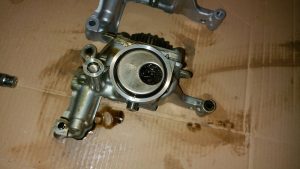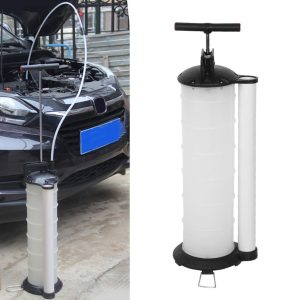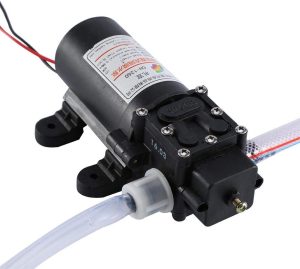Although it is known as a vacuum pump, users may also call it an oil removal engine and put it to work with any kind of automotive fluid, including oil, transmission fluid, brake fluid, and coolant, among others. Before oil is amended or replaced, the most dependable method for removing old oil as well as any impurities and pollutants is to use a pump that draws in the liquid using suction. When changing the oil, having an oil pump avoids the need to lift the vehicle, crawl beneath it, unscrew the oil cap, and pour oil into a bucket. This is a significant time saver although on older cars, this may be required to change the oil filter.

After inserting a hose into the pipe and connecting it to a pump unit with the assistance of a suction pump, the liquid is pumped out of the pipe, resulting in the creation of a vacuum. There are many different types of oil pumps, the majority of which are driven by hand pumps such as pedal or bicycle pumps. However, there are also pumps that are powered by electricity or compressed air. When selecting the appropriate pump, it is important to take into account the following factors: pumping efficiency, which is the length of time it takes to pump a certain quantity of liquid, reservoir capacity that must be large enough to hold all the liquid that needs to be pumped without leaving it empty. In the midst of the task, the pricing is the same as it has always been.
Engine oil pump
Unexpectedly, an oil pump is what’s responsible for keeping the oil in an internal combustion engine circulating properly. The engine’s lubrication system includes an oil pump that is responsible for pressurizing the oil that is pumped out of the engine. It draws oil from the oil pan and distributes it to the sliding pistons, revolving bearings, and camshaft of the engine. The transmission of pressurized lubricating oil to the various moving elements of the engine is the primary objective of this particular system. The motion of the oil pump helps to maintain the engine at a comfortable temperature.
In this part, we will talk about the definition of an oil pump, as well as its functions, principles of operation, schemes, kinds, and common faults in internal combustion engines. An oil pump is a mechanical device that is used in an engine to circulate oil to moving components such as bearings, camshafts, and pistons in order to avoid wear and tear on the moving elements of the engine. This is one of the most critical components of the system that lubricates the engine, and if it fails in any way, the system as a whole will collapse.
The oil pump of an automobile is one of the most important components of the engine, since it is responsible for delivering pressurized oil to the engine. Because of this, there is less circulation of engine oil throughout the engine. It guarantees that the oil will flow in the correct direction via the pipes and to the various components. This assists in returning the hot oil to the tank with the cooling oil so that it may be used again. Always make sure that the engine has a steady circulation of oil.
Engine oil removal pump
The oil pump is an essential component of the engine lubrication system for pumping and removal of the oil and plays a significant role in the lubrication process. The crankshaft is typically the component that is responsible for driving the oil pump, which usually begins operating as soon as the engine is turned on. Fuel injectors are not employed in oil-free engines such as the two-stroke engine. Other types of oil-free engines include the four-stroke engine.

After passing through a heat exchanger to be cooled, the oil is filtered before being pumped into the pump. The working portions of the engine are connected to the oil chamber by passageways that enable cooled oil to be returned there from the functioning sections of the engine. If there are fuel injectors in the engine, then a little portion of the oil will be delivered straight to those injectors. Oil is inserted to fill the area between the piston rings and the cylinder walls in order to provide protection for the cylinder walls from the piston rings. This results in an increase in the overall efficiency of the engine since the compressed air is prevented from leaving via the piston.
A pressure of up to 10 psi may create around 55–65 psi from an engine when it is rotated at 1000 rpm. The pressure that is put on the crankshaft journals and bearings may be decreased to between 50 and 60 pounds per square inch when a correct pump drain valve is used. The relative speed of the crankshaft journals, which is measured in feet per second, is what generates this high pressure in the engine. When adjusting the bearing clearance, it is important to keep the bearing, bearing width, oil viscosity, and temperature in mind in order to get the best possible outcomes.
Engine oil vacuum pump
A vacuum pump for engine oil, like the ones that our company manufactures, is able to perform two distinct functions while only using a single piece of equipment. The vacuum that is necessary for pneumatic operations, such as brake boosters, EGR valves, swirl drives, and exhaust gases at exhaust gas turbochargers, wastegate valves, and central locking, is generated by a mechanical vacuum pump in modern diesel and gasoline engines that have low intake manifold vacuum. These pumps are used in engines with low intake manifold vacuum. These pumps are often located in motor vehicles. The variable oil pump is responsible for lubricating the engine, and it has the ability to provide the appropriate quantity of oil to the circuit in any given circumstance while only requiring a very little amount of torque. By altering the displacement, it is possible to lower both the amount of gasoline used and the amount of CO2 emissions.
By using a revolving vane that is eccentrically placed inside the pump case, the vacuum pump is able to produce a vacuum within the pump case. It does this by generating a compression chamber followed by a suction chamber in rapid succession, which ultimately leads to the production of a vacuum. Simultaneously, the variable oil pump, which is also based on the vane principle, may offer engine lubrication by self-adjustment, two pressure phases, or entire map control. These options are all viable alternatives. The user has the ability to choose from all of these options.
Engine oil extractor pump electric
This kind of pump is also referred to as a electric extractor for engine oil. It is made up of an internal gear that is rotated by an external rotor that is located on the outside of the device. The outer rotor has one more vane than the inner rotor, which means that the mounting point of the inner rotor is somewhat offset from the center of the outer rotor. Because of this, the outer rotor will revolve at a speed that is about 80 percent that of the speed of the inner gear. A tail pump is produced as a result, which takes oil in via the intake and expels it through the exit. To guarantee efficient pumping, rotary oil pumps need that the tolerances be kept very close. The pump is attached to the crankshaft in its permanent location.

Double gear pumps, often known as external pumps, are another name for these types of pumps. At the very bottom of the engine, in the oil pan, it is secured into place. When it comes to pumping oil, it makes use of two gears that mesh with one another. Both the shaft and the first gear are driven by the second gear, but the first gear drives the shaft. Depending on the kind of engine, the crankshaft, the camshaft, or the camshaft may be linked to the shaft that drives the first gear. Oil is fed into the gear via the teeth, which then channel the fluid through the intake tube and out the outlet, which is located around the gear. There is a small but significant space between the gears to prevent oil from leaking back into the intake port.
Engine oil extractor pump AutoZone
On AutoZone, you may notice several frequent engine oil pump issues. In particular, if the driver is ignorant of the warning indications that indicate a problem, a faulty fuel pump may cause significant damage to a vehicle. When there is an issue with the vehicle’s engine, the driver is alerted, and the oil level indicator located on the vehicle’s dashboard illuminates to indicate a problem. The following are indicators that an oil pump is not operating properly; Low Oil Pressure: If the oil pump has become old or malfunctioning, it will not be able to pump oil into the system as it should. This will result in the oil pressure falling below the safe level, which will cause damage to the engine. Despite the fact that we’ve already covered a number of the warning signs associated with low oil pressure in this article.
The reduction in friction that the oil provides in an automobile engine causes an increase in the temperature at which the engine is working. Since there is no change in the amount of oil flowing through the engine while the pump is functioning properly, the engine’s temperature will remain normal. Nevertheless, even when the oil flow is reduced or ceases entirely, the components are still lubricated with hot oil that is unable to circulate. Hydraulic lifters in automobiles have the potential to begin creating a noise if they have not been adequately greased. They don’t make a sound when everything is operating as it should with the oil pump and the circulation of oil. Because it is quite costly to replace the lift, we make sure that the crucial engine never runs out of oil.
Your comment submitted.